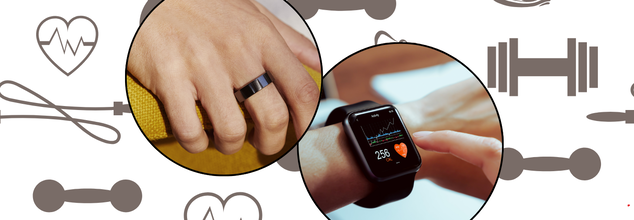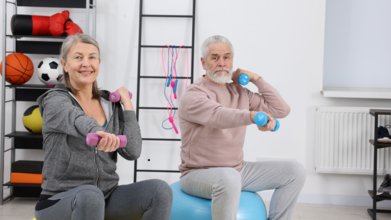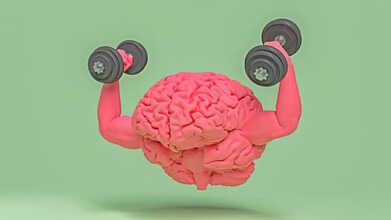- Health Conditions A-Z
- Health & Wellness
- Nutrition
- Fitness
- Health News
- Ayurveda
- Videos
- Medicine A-Z
- Parenting
- Web Stories
Are Smart Rings Worth The Hype? How Do They Compare To Fitness Watches

You're walking through your day, effortlessly monitoring your health, steps, and heart rate without the bulk of a fitness watch on your wrist. Rather, a sleek smart ring lies unnoticed on your finger, working its magic quietly in the background. Interested? You're not the only one. With all the hype over these little tech wonders, people are wondering if they're actually as accurate as their clunky cousins—the fitness watch.
Smart rings are a trendy, minimalist version of the old-style fitness watch and have been widely adopted by health tech buffs, athletes, and even medical practitioners. They come in sleek form, being undistinguishable as jewelry, loaded with strong sensors that can measure sleep, heart rate, and a multitude of wellness indicators. But at what price: reduced accuracy because they are so small? And most importantly, can they really compete with—or even outdo—smartwatches in health monitoring?
The answer is not so simple. Smart rings might be less capable in some respects, but recent studies and developments indicate that they have promising strengths, particularly in the accuracy of some health measurements. Here's an in-depth, exclusive comparison of how smart rings compare to fitness watches.
Smart Rings vs. Smartwatches
At the core of both smart rings and smartwatches lies the same foundational technology—photoplethysmography (PPG). This method uses light-based sensors to measure changes in blood volume, providing real-time data on your heart rate. However, where the device is worn makes a significant difference.
According to a 2022 review in Frontiers in Physiology, the finger is a more vascular-rich area compared to the wrist. That is, smart rings might provide more accurate readings, particularly for heart rate tracking, due to the proximity of the finger to rich blood vessels. Also, a study published in 2023 in Mayo Clinic Proceedings: Digital Health pointed out that smart rings might provide more accurate readings of heart rates in individuals with darker skin. The palm contains less melanin than the wrist, minimizing the light distortion that PPG sensors tend to have trouble with.
However, they have their prerequisites. Motion artefacts—motion-induced interference—can warp smart ring readings, particularly during exercise. According to a 2021 study in the Journal of Electrical Bioimpedance, even minimal movement of the finger during light exercise can invalidate ring-based sensor accuracy. And not like smartwatches, smart rings generally have no onboard GPS and sophisticated accelerometers, thus restricting their use in monitoring challenging workouts or runs.
Even with some immediate limitations, smart rings are rapidly advancing. New prototypes indicate that these wearables may soon far surpass heart rate and sleep tracking. One exciting advance is the result of a January 2024 paper published in IEEE Transactions on Mobile Computing, which introduced a smart ring to track hand hygiene in real time—a revolution in healthcare environments. The ring's electrochemical fluid sensor proved to be 97.8% accurate, more than a 10% improvement over available electronic hygiene monitors.
Another 2021 Computer Modeling in Engineering & Sciences study presented a ring that would be able to sense early hand tremors, an early sign of Parkinson's disease. As research advances, experts envision future rings will even track blood glucose, hydration, and blood pressure—marking the beginning of a new era of passive, ongoing health monitoring.
Sleep Tracking and Wellbeing
When it comes to sleep monitoring, smart rings really shine. Their light, non-intrusive nature makes them perfect for wearing overnight. Unlike smartwatches—which are often found to be cumbersome in bed—smart rings can easily track your sleep without disturbing you.
Brands take it a step further, providing detailed information on energy levels, sleep phases, recovery, and even the best time to consume caffeine. Although a 2024 meta-analysis in Applied Sciences noted that smart rings tend to underestimate REM sleep, they still provide a holistic picture of sleep patterns by integrating data points such as heart rate variability, respiratory rate, and skin temperature.
Nevertheless, experts warn that such rings should be employed to identify trends, not to diagnose sleep disorders. "Smart rings can help identify trends, but they can never replace a sleep study that monitors brain activity," said wearable tech researcher Semitha.
Comfort, Design, and User Preference
Comfort and style are huge pluses for smart rings. They are less obtrusive and better-looking than clunky wrist-mounted devices, making them easier to incorporate into daily wear. But all is not great in the design world. Even with their streamlined marketing, many rings look clunky on smaller hands, and matte finishes tend to wear off after a while with regular use.
Smartwatches, in contrast, have adjustable sizes and removable straps, which may be attractive to those looking for flexibility. Premium smartwatches are more likely to be stronger, since they are manufactured from superior materials and designed to endure intense use.
Which One Is Best for You?
Ultimately, deciding between a smart ring and a smartwatch comes down to your individual health objectives, way of life, and personal comfort level.
If you're a fitness buff requiring precise workout tracking, GPS, and exercise recognition, a smartwatch is still the better choice.
If you're more concerned with sleep quality, daily readiness, recovery, and overall wellness—and don't mind something less invasive—a smart ring could be a game-changer.
For those who value medical-grade accuracy, both devices still lag behind clinical equipment, but smart rings potentially have more future potential because they are closer to high-fidelity data points.
Significantly, neither device is 100% accurate, but both can give you useful insights that enable you to make healthier lifestyle choices.
Smart rings are more than a fad. They are a new convergence of design, health, and technology that will have significant potential to become powerful weapons in personalized healthcare. As technology continues to improve in sensors, the distinction between wearables and medical devices might get blurred, and users could become empowered to take proactive actions towards their healthcare.
In the meantime, these rings can be thought of as hot trend friends to your health journey—not as alternatives to professional health care, but as virtual cues toward improved behaviors.
As the health tech landscape continues to evolve, the finger may just become the most important real estate in wearable innovation. And with every ring that tracks your sleep or your heart rate, we're one step closer to a future where wellness is literally at your fingertips.
Working Out These 5 Zones Can Help Older Adults Stay Fit, According To Fitness Expert

Credits: Canva
Strength training becomes increasingly important as people age, but many older adults make the mistake of training only the muscles they see in the mirror. According to Marfred Suazo, a New York City, based fitness professional known as “Fonz the Trainer,” who spoke to Fox News, targeting overlooked muscle groups is the key to moving well, staying pain-free, and living independently.
Suazo, who has trained thousands of seniors, shared with Fox News Digital which areas of the body matter most as we get older, and why focusing on them builds true longevity.
Moving Beyond “Mirror Training”
“Most people train what they see in the mirror, chest, arms, quads, and maybe abs if they’re feeling ambitious,” Suazo told Fox News Digital. “That’s what I call mirror training.”
While this type of workout may boost appearance, Suazo explained it leaves people unbalanced, with rounded shoulders, tight chests, and sore backs or knees.
“If you want to age strong, pain-free, and confident, you need non-mirror training,” he said. “That means working the muscles you don’t see but feel every single day.”
Zone 1: Power Zone — Glutes and Hamstrings
These muscles form the foundation of movement, helping with sitting, standing, climbing, and protecting the lower back.
“Your glutes and hamstrings give you the power to move with confidence,” Suazo said. He recommends deadlifts, hip thrusts, and single-leg bridges. “Control the movement, squeeze at the top, that’s where the real work happens.”
Zone 2: Posture Zone — Upper and Mid-Back
Strengthening the back keeps the body upright and breathing freely. Without it, posture often collapses into a slouch as people age.
“A strong back pulls your shoulders into alignment,” Suazo explained. His go-to moves include bent-over rows, cable rows, and bodyweight rows. “Pull through the elbows and picture yourself standing taller with every rep.”
Zone 3: Stability Zone — Core and Obliques
The core isn’t just about six-pack abs, it’s about stability and spine protection.
“True core training teaches your body to brace and protect your back during daily life,” Suazo said. His favorite move is the Paloff press: anchor a band, press it straight out, and resist rotation. “It’s simple, but it trains real-world stability.”
Zone 4: Mobility Zone — Shoulders and Rotator Cuff
Shoulders are involved in almost every upper-body movement. When they’re weak or stiff, everything else suffers.
“Healthy shoulders are a must if you want to keep training for decades,” Suazo told Fox News Digital. He suggests face pulls, rear delt flies, band rotations, and controlled overhead presses. “This combination keeps shoulders strong and mobile.”
Zone 5: Grip Zone — Hands and Forearms
Grip strength is directly linked to independence as people age, yet it’s often one of the first things to decline.
“Grip strength makes a difference in every other lift and in everyday tasks,” Suazo said. He recommends farmer’s carries — aiming to carry about 70% of body weight in total — as well as simple hangs from a pull-up bar.
A Simple Routine to Start
For beginners, Suazo suggests a quick non-mirror workout:
- 3 sets of 8–10 deadlifts
- 3 sets of 10 Paloff presses per side
- 3 farmer’s carries for 30–45 seconds each
- A short walk to finish
- Training for Longevity, Not Just Looks
Suazo emphasized that safety and form come first, especially for older adults. “Controlled movement matters more than how heavy you go,” he said. Warming up, progressing gradually, and listening to the body are essential.
“Non-mirror training is how you stay strong, upright, and pain-free,” Suazo added. “When you train the muscles behind you, the ones in front look and perform better too.”
Fitness Coach Reveals 7 'Cheat Codes' That Help You Burn More Calories While Walking

(Credit- Canva)
What is an exercise that not only needs minimal equipment, but is also the most accessible for everyone, no matter how young or old they are? It is walking. Not just by fitness coaches, but also healthcare professionals, walking is regarded as one of the best ways to stay fit and healthy.
If you are looking to lose weight, but are worried about committing to a gym membership that you may not be able to finish, then you do not need to worry about elaborate home workouts, all you need is a pair of shoes and time to take a powerful stroll. But did you know, you could maximize this time and make your walking more efficient? Not only will this allow you to make the most of your time, but it will also help you lose weight easier?
According to fitness coach Dan Go, you can make your walks far more effective. He's developed a set of simple "cheat codes" that can help you burn more fat, significantly boost your energy levels, and even add years to your life. It's often seen as a simple, low-impact activity, that is easy to adjust to your levels of fitness. These small adjustments to your walking routine can lead to truly massive results.
7 Walking Tricks To Help You Lose Weight
Japanese Interval Walking
Forget boring, steady walks. This method involves a powerful rhythm: walk fast for three minutes, then slow for three minutes. Repeat this for 30 minutes. This style of walking is scientifically proven to burn more fat and significantly boost your fitness more effectively than a constant pace.
Walk on an Incline
Adding an incline to your walk, either on a treadmill or a hill, dramatically increases your calorie burn. A 5% incline can boost your burn by 50%, and a 10% incline can double it. It’s also gentler on your joints and works your glutes and hips more.
Walk After Meals
Just a short 2-5 minute walk after eating can make a huge difference. This simple habit helps lower blood sugar spikes by about 30%, which means you'll have fewer cravings, steadier energy, and your body will be less likely to store fat.
Try a Fasted Morning Walk
Walk before you have breakfast. When you walk on an empty stomach, your body is more likely to use stored fat for energy. Doing this outside also helps set your natural body clock and gives you a refreshing boost to start your day.
Walk While You Work
For those with a busy schedule, a treadmill desk is a fantastic solution. You can get in thousands of steps while you're at your standing desk. This lets you multitask and be active during meetings or while you're working on tasks.
Pyramid Walking Intervals
This method is a great way to improve endurance and burn fat. Start with an easy 5-minute warm-up, then gradually increase your speed and incline every 10 minutes. Finish with a four-minute push at your toughest pace before a cooldown.
Rucking
Turn your walk into a full-body workout by wearing a backpack with 5-10% of your body weight. This simple addition helps you burn more calories, while also strengthening your legs, core, and bones simultaneously for a more challenging and effective walk.
Can Leg Workouts Help Protect Your Brain From Ageing? Expert Weighs In

Credits: Canva
If staying sharp as you grow older is the goal, skipping leg day may not be the best idea. New findings suggest that your brain could benefit just as much as your body from squats and lunges.
A long-term study, first published in Gerontology by Karger Publishers, tracked older female twins for ten years to explore the link between leg strength and cognitive health. The results were clear: participants with stronger legs at the beginning of the study experienced far slower cognitive decline than those with weaker leg muscles.
To understand this connection better, we spoke with Dr. Indramani Upadhyay, MPT (Ortho), HOD – The Center for Knee & Hip Care, Vaishali, Ghaziabad, who shared his insights on the subject.
The Leg–Brain Connection
When we think about keeping the mind sharp, the usual suggestions include solving puzzles, reading, or practicing meditation. Yet growing research shows that one of the strongest ways to support brain health actually starts with the legs. As per Dr Upadhyay, strong leg muscles do more than keep us steady, they play a vital role in protecting memory, learning, and overall cognitive function.
Because the leg muscles are the largest in the body, every time they are put to work they send powerful signals that influence brain chemistry, circulation, and even the growth of new cells. Studies highlight several key benefits:
- Better blood flow: Leg-focused exercises improve circulation, delivering oxygen and nutrients the brain relies on.
- Myokine release: Contracting muscles release proteins known as myokines, which travel through the bloodstream and support nerve health and brain adaptability.
- Neurogenesis boost: Weight-bearing moves like squats and lunges may encourage the growth of new neurons in the hippocampus, the region responsible for memory and learning.
- Stress balance: Physical activity in the legs helps regulate hormones, easing inflammation and reducing stress—two major factors linked to cognitive decline.
Which Leg Exercises Boost Brain Health?
Dr Indramani explains that keeping your legs active does far more than build strength or tone muscles, it also supports brain health. Here are some of the most effective exercises:
1. Strength Training (Squats, Lunges, Step-Ups)
Movements that use your body weight or added resistance work the largest muscle groups in the legs. These exercises not only build muscle and protect bone health, but they also trigger the release of growth factors that sharpen memory and learning.
2. Walking and Jogging
Brisk walking or light jogging are simple yet powerful ways to improve cardiovascular fitness. Better circulation means more oxygen-rich blood reaches the brain. Walking outdoors adds even more value by lowering stress and boosting focus.
3. Cycling
Whether on a road bike or a stationary one, pedaling engages the legs continuously, keeping endurance and blood flow steady. Research links cycling to better reaction times, sharper executive function, and a lower risk of age-related cognitive decline.
ALSO READ: Ebola Outbreak: Why African Countries Are Disproportionately Impacted By The Disease?
4. Yoga Poses (Tree, Chair, Warrior Stances)
Balance-focused yoga postures recruit the legs while also improving flexibility and coordination. This mindful movement helps ease anxiety, sharpen concentration, and strengthen the mind-body connection.
Putting It All Together
The most effective routine is a balanced one: strength training two to three times a week, daily walking or cycling, and yoga for flexibility and balance. Together, they create a foundation that protects both body and brain.
Your legs are more than just a means of movement. They are engines that power your mental resilience. Keeping them strong is an investment not only in mobility but also in memory, focus, and long-term brain health.
© 2024 Bennett, Coleman & Company Limited

